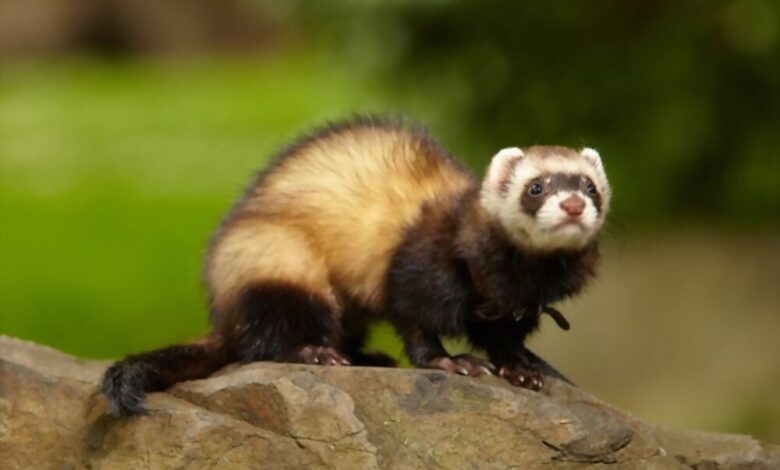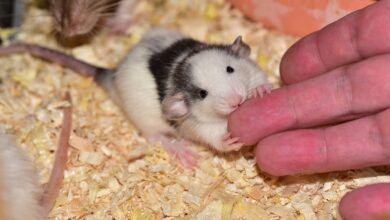Ferret

Variety: Ferret
A real little ball of hair with a lifespan of 8 to 10 years, a ferret will become, as it is educated and tamed, an adorable companion. In truth, it is not characterized as a rodent, it is part of the mustelidae family. It is a very intelligent, sociable and rather playful animal. Its memory capacity is great. Some of his reactions can be anticipated. Others simply mean his general state: stressed, amused, fearful, fearful, aggressive. A ferret can bite for various reasons. In general, this is never very bad. This is often the case during games, when he is not happy or simply inadvertently, especially among the youngest.
Way of life :Diurnal
Feed :Carnivore
Behaviour :Sociable
Weight and height :From 500 g to 2 kg
Size: From 40 cm to 60 cm
Historical
The ferret belongs to the Mustelidae family. It is a subspecies of the Polecat . The first domesticated ferrets date back to the first millennium BC . Apparently, they did not exist in the wild before. As such, a ferret abandoned in the wild has every chance of dying. The domestication of this animal would have started on the side of North Africa. It was used for hunting in the 4th century BC. For their part, the Romans used them to hunt mice and rats.
Deratting was also its role during the conquests in the middle of the Middle Ages and during the Renaissance. Not all colonies of ferrets that have been attempted to return to the wild have survived. In more contemporary times, during the first half of the 20th century, the ferret was used in the laboratory to advance in the medical field and in particular in virology . Indeed, the ferret is an animal likely to suffer from the flu. The animal gradually integrates homes from the 1970s. First albino ferrets, then ferrets having had a cross with the polecat.
Physical peculiarities
The true only breed of ferret is the polecat ferret , since it is crossed with the polecat. For the rest, ferrets are differentiated by their colors. There are more classic ones (predominantly colored hair compared to white, darker colors on the tail and legs than on the rest of the body) and others, such as full or self type ferrets, with colored extremities, Siamese ferrets. Note that the Ferret changes color during its moulting periods, which take place twice a year. In addition, the Ferret can measure up to 60 cm including its tail. It usually weighs up to 1 kg in females and up to 2 kg in males. It has a fairly slender, elongated body, a robust skull and small round ears.
Its body : solid and in several parts: head, trunk, tail.
His hair : there are 2 kinds of hair: the guard hair, a little longer and harder than the undercoat, which is quite short.
Its color : originally, the first ferrets were albino. Today, Ferrets are generally all colored, with none really standing out.
Its head : triangular in shape and quite long.
His eyes : round in shape, black in color (sometimes red) and shiny.
His ears : small.
Its tail : the tail of the ferret is of fairly average size, from a good ten centimeters to almost 15.
Behavior and character
The ferret is a crepuscular animal . He can sleep up to 20 hours a day . It is an animal that can be described as gregarious , even if it manages to live on its own , provided that we take care of it often enough. For this purpose, he needs play time with his owner daily. Very intelligent , it is a playful animal that interacts perfectly with other animals such as cats and dogs .
Curious, he will try to hide when he is released in a room in the home, above all to play. Sterilizing a ferret reduces its behavior, especially during the breeding season. A male will be less aggressive, for example. Having 2 unsterilized ferrets live together can be dangerous for them. Be sure to take into account that a male ferret has a stronger body odor than a female.
Reproduction
The female ferret is able to reproduce from its first heat , around the ninth month . Gestation lasts an average of 42 days . There can be up to 2 litters per year which can contain 8 new ferret babies . During gestation, the ferret must have a specific diet with a level of animal protein higher than normal. Ferrets should not be rationed during the gestation period.
Once the delivery is made, the ferret will have to remain calm on its side with its young, without stress. The slightest anxiety factor can lead her to abandon her newborn babies or eat them. Like mice or rats, babies are born blind and naked. They will only open their eyes from the fourth week of life. Weaning occurs between 6 and 8 weeks. From this moment, the small ferrets begin to play, to be curious and to socialize.
Living conditions
Playful and particularly active, a ferret needs space to flourish and be entertained. Thus, the size of his cage , his place of life par excellence, will have to be at least one meter in length, half a meter in width and height . Indeed, the cage should not necessarily be high, since the ferret could fall and thus be hurt. It is necessary to favor a metal cage, with bars . These must be relatively tight to prevent the ferret from getting hurt. Plexiglas and plastic cages are to be forgotten since they convey air very badly. The best would be to build the ferret’s own house, taking care to stack several floors. A custom cage, but which allows the ferret to feel more at ease.
It is necessary to ensure a rather complex closing system . The ferret, very clever, will undoubtedly try to get out of the cage on its own. Thereafter, the cage will have to include several places well defined in advance. A rest area with a warm and comfortable corner, a tunnel and a hammock why not. A dining area with a bowl of food and a bowl of water. A play area with hiding places, tunnels and even a ladder. Finally, a corner for the needs for this particularly clean animal. Do not forget to take the ferret out of its cage daily, where it should not spend all of its days, otherwise it will wither away.
Health
Ferrets are very disease resistant . However, it can happen to him to fall ill and thus risk dying depending on his pathology. Sick, the ferret will present soft stools, dry eyes, his hair will no longer be smooth or silky and his coat may have holes. Ferrets can develop distemper, caused by the Morbillivirus virus. You must have your ferret vaccinated to prevent the appearance of this incurable and fatal disease within a fortnight . He can also catch gastroenteritis in connection with an unsuitable diet, heat stroke or too much stress.
The ferret is also one of the few animals that can declare the flu . It is more dangerous than in humans and particularly contagious. No treatment is to be taken since it goes away on its own if the ferret is lucky enough to survive. Because the disease can greatly weaken it. He also develops adrenal disease caused by hypersecretion of sex hormones by the adrenal glands. This mainly affects sterilized ferrets over 3 years old. Aleutian Disease (ADV) can affect it. This causes general weakening and death in all cases.
Life expectancy
Minimum :5 YEAR
Maximum :10 YEAR
Feed
The domestic ferret is a strict carnivore . It does not support vegetable proteins . However, it is necessary to pay attention to its not very efficient digestion . He has a great need for animal protein but cannot be satisfied with meat alone at the risk of suffering from deficiencies. Animal proteins must correspond to more than a third of its daily ration. Avoid croquettes sold in pet stores or shops , they contain above all vegetable proteins. The ferret needs about 30% fat (lipids) but does not necessarily have an obvious need for fiber.
Its diet consists of 3 essential foods : meat foods (small prey such as mice, quail, poultry carcasses), wet foods (not recommended because it promotes tartar deposition) and kibble (50 grams per day). Treats such as fresh raw meat, cooked eggs, juices, cucumbers and grapes are possible, but should be given in moderation and sparingly, as they promote obesity. Finally, several foods are unsuitable because they are toxic, such as milk, tobacco, alcohol and chocolate in particular.
Maintenance and hygiene
Daily, the ferret needs to be cared for and to live in a certain comfort for a healthy lifestyle. The ferret is a very clean companion. He grooms himself every day . Attention should be paid to his claws , coat and teeth to avoid dental malocclusion . Its ears can also be cleaned, but with delicacy , as it is a very sensitive organ. Be sure to brush the ferret’s coat well to remove dead hair.and leave a shiny and silky coat. On the other hand, it is not necessary to give baths to a ferret, since it carries out its toilet alone.

